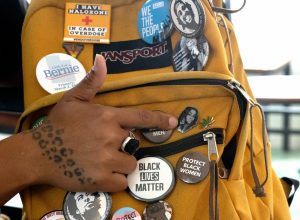- Slug: BC-CNS News21 Transparency, 3,910 words
- 7 photos and captions below.
- 1 video here (4.18 minutes), credit Kate Heston/News21
By Kate Heston, Brooke Newman and Kyra O’Connor
News21
ARLINGTON, Texas – It was 1:16 a.m. when Trena Miller and her wife heard a knock at the door at their home. A police officer told them their son had been injured during a traffic stop.
Thirteen minutes after the knock, 20-year-old Tre’Shun Miller died at a hospital – without either of his mothers there.
Trena Miller, seeking to learn what happened during the 2019 traffic stop, requested records from the Arlington Police Department. Police denied the request, stating she had to wait until they completed the investigation. She pursued the records through the district attorney’s office and received them – nearly six months after Tre’Shun’s death.
For Miller, understanding what happened the night her son died – through complete, unedited body camera footage, police reports and medical documents – changed her family’s life.
“Not knowing sometimes how your baby died, not knowing if he suffered or not, not knowing the details of what took your child from you can be so much more agonizing because it allows your mind to wander,” she said.
Since she obtained the records, Miller said she has helped others in nearby Fort Worth by sharing information about how to access information and advocating for open records.
Across the country, that effort to increase transparency has become a standard rallying cry in the police reform movement, with activists demanding that law enforcement open up their use-of-force reports, body-camera footage and misconduct data to improve accountability and build trust with the community.
The efforts have been met with resistance.
Congress repeatedly has failed to pass comprehensive legislation mandating more transparency, specifically in areas of police misconduct and use of force. State legislatures often thwart transparency bills, and police unions continue to fight such efforts at both the local and state level.
Joe Ferguson, deemed “Chicago’s longest-serving watchdog” by the Chicago Sun Times, said the government hasn’t made transparency an institutional value – one of the largest hurdles to accomplishing transparency within policing.
“We are not going to get where we need to be until government is proactive about transparency. And it won’t be perfect,” said Ferguson, who spent 12 years as Chicago’s inspector general. “People will still – and constituencies will still – need to push, and want and need more.”
Americans are doing just that: Demanding more.
Although widespread, comprehensive reforms to increase transparency in policing haven’t materialized, some policymakers, law enforcement officials and community leaders are trying to drive change – however incremental. They have passed laws and adopted policies to open records and track behavior, or forced departments to do so through orders or lawsuits. And when some departments still deny transparency efforts, groups have taken on the task themselves.
“Transparency is a pathway to a resolution,” Miller said. “I do believe that because if I don’t believe it, then what am I fighting for?”
Policing is ‘extraordinarily unregulated’
The list of what the public doesn’t know about America’s roughly 18,000 local law enforcement agencies is long.
The federal government doesn’t track how often local police departments use force. It doesn’t keep tabs on officer misconduct cases or officers fired for bad behavior. And it doesn’t require law enforcement agencies to collect their own data in these areas.
Without collecting and analyzing data, departments can’t identify problems and implement change. And without releasing the information, public trust in law enforcement is broken or nonexistent.
In a recent survey of 3,000 people nationwide, commissioned by tech company Veritone, 42% said lack of transparency had hurt their perception of police in the past five years.
Walter Katz spent two decades in public service with a focus in law enforcement accountability and oversight. In 2019, he led the design and development of the Office of Violence Prevention in Chicago. As vice president of criminal justice at Arnold Ventures, a philanthropy dedicated to research and solutions, Katz researches and writes extensively about police reform.
“Policing is one of the most high risk professions, with tons of contact with civilians, and the irony is that, despite how high risk the profession is, it is extraordinarily unregulated,” he said.
When the government tried to keep better tabs, it failed.
The FBI began collecting use-of-force data in 2019 to try and get a better handle on incidents of excessive force across the country. But the government can’t force police departments to use it, and many don’t.
As a result, the database is underreported, and the FBI does not meet the requirements to operate the database beyond December 2022, according to the federal Office of Management and Budget.
The database collects data from three events: when a fatality occurs; when there’s serious bodily injury; or when a firearm is discharged. Events that don’t meet this criteria are not collected.
“They weren’t capturing very much,” said Lewis Coggeshall, a police sergeant in Arlington, which is between Fort Worth and Dallas. “We had 900 and something use of force incidents last year, but only two of those were reportable to the FBI.”
The lack of a federal mandate to collect or report certain critical measurements of policing accountability means states have different standards.
For example, Arizona keeps no database law enforcement agencies can use to check an applicant’s discipline records during the hiring process. State Sen. Martin Quezada, a Democrat who represents west Phoenix, said the lack of information results in problematic officers “gaming the system and bouncing from agency to agency.”
Other states have tried to address what’s often called the “wandering officer phenomenon.” Wisconsin, for example, has a new law that requires law enforcement agencies to review personnel files from previous employers.
In Milwaukee, Donyae Robinson, a member of Black Leaders Organizing for Communities – a community group known as BLOC – said there’s little trust between the community and police officers. Some of that stems from the authority police have. Robinson said police can “flex their muscle, and they can do things that they that they want to do” – and don’t necessarily have to face repercussions.
In the calendar year after the May 2020 murder of George Floyd at the hands of Minneapolis police, 49 states proposed legislation to increase transparency in policing. Of those, 42.8% focused on misconduct, according to a News21 analysis of data collected by the National Conference of State Legislatures.
Overall, the bills had vastly different goals, ranging from increasing protections for police officers to what activists have described as “throwing the library open” when it comes to records.
Police departments also vary widely in the information they share and the policies they implement. Some post a wide range of data online, but others charge high fees or require residents to fill out cumbersome forms.
As executive director of the Freedom of Information Foundation of Texas, Kelley Shannon fights for public access to records by educating the public, lobbying the Legislature, sharing updates and fighting for records in court.
Documents belong to the public, she said.
“They belong to ‘We the people,’ they’re our documents, and we have every right to see them,” Shannon said. “It’s just really how democracy works, its information is essential for the correct operation of democracy, free flow of information is what you need for a democracy to work.”
Why it’s contentious
Some common demands in the police reform debate include timely access to body camera footage, complaints against officers and misconduct and disciplinary records. But police and their unions often fight these efforts.
Thomas Mungeer, executive director of the New York State Troopers Police Benevolent Association, said if other professionals, including lawyers and journalists, were asked for their background records, they wouldn’t be accessible.
“However, with police officers, everybody thinks, ‘Oh, that’s great,’” Mungeer said.
Jim McNeff, a former police officer in Orange County, California, and former news editor for Law Enforcement Today, agreed. In his 31 years in law enforcement, he said, most complaints were unfounded.
“Police officers make a lot of enemies doing the job,” McNeff said. “If every time someone complained about us, if that became a matter of public record, like, show me the door, I wouldn’t work there.”
However, those complaints from the public – even if later determined “unfounded” by police – can play a critical role when it comes to oversight, said Michael Sisitzky, assistant policy director at the New York Civil Liberties Union.
“They speak to the issue of what it is actually like for investigators to go through the process of determining whether an allegation of misconduct occurred, and whether there’s cover-ups of misconduct within police departments,” he said.
McNeff said policing is one of few professions where the public advocates for the release of misconduct records. He said public personnel files can be dangerous for any institution, not just law enforcement.
“It’s bad for any institution to have personnel files as a matter of public record, because you’ve got some very, very vicious people out there that will not hesitate to ruin the profession of another individual,” McNeff said.
Pamela Grayson, director at Collective Activism Social Justice Coordination Center in Dallas, said police officers need to be held to a higher standard, and that includes making personnel files public.
“Here’s the thing, you’re not born blue. I was born Black. You chose to be blue. I love, and cannot change, being Black,” said Grayson, whose nonprofit activist group focuses on social justice issues. “You chose to become an officer, so you chose to be held to that higher standard. You are supposed to be above reproach, morally.”
Some activists also have pushed for residents to have seats at the table through advisory or civilian review boards.
Jim Ross doesn’t think that’s a solution for law enforcement.
Ross, a former Marine and police officer, now wears several hats as a restaurant owner, lawyer and mayor of Arlington. Although Ross deals with many advisory boards as mayor, he said civilian oversight of law enforcement is a poor review process, not transparency.
“If you want to give your community comfort in policing,” Ross said, “you have to be transparent. Now, that doesn’t mean I believe in a citizen review board. I don’t. Because what you’re doing is asking nonprofessionals who don’t know anything about use of force policy, state laws, force continuums, self-defense, anything like that, to judge a situation and how a police officer responded.”
But Sisitzky said there are times where police can’t be trusted to police themselves.
He pointed to a 2019 report by the Office of the Inspector General for the New York City Police Department that analyzed about 35% of the nearly 2,500 complaints of biased policing that had gone to the internal affairs department, “zero of which had been substantiated, which just flies in the face of common sense.”
The report found numerous deficiencies in the police department’s internal investigations, including failing to conduct interviews with the officers and complainants.
How transparency occurs: Legislation
Across the country, state lawmakers have introduced more than 700 bills that deal with transparency since mid-2020. Only 18% had been enacted as of July, according to a News21 analysis of bill tracking by the National Conference of State Legislatures.
Quezada, the Arizona senator, has repeatedly tried to move transparency legislation through his state. Over the past two years, he has proposed eight bills – from addressing officer misconduct and decertification to use-of-force. Most never even received a hearing in the Republican-led Legislature.
“In Arizona, there’s a powerful law enforcement lobbying effort, which infiltrates all levels of politics,” Quezada said, adding that “bills which would normally have broad public support become politicized, because the people in power are politicizing them.”
A Republican sits in the governor’s seat and the GOP narrowly controls both chambers of Legislature. Arizona is known for its conservative agenda, and lawmakers have blocked most police reform legislation in recent years.
But some states have seen more success. Utah, for example, enacted five of its eight transparency bills this year.
Rep. Mark Wheatley worked on legislation to address expedited release of body camera footage for two legislative sessions. In 2021, his efforts failed because he didn’t have broad support from law enforcement.
“There has always been an issue about the release of police recordings,” said Wheatley, a Democrat who represents South Salt Lake City. “When a police officer causes or shoots at an individual … the public has a right to know. But then the individual has the right to a fair trial, so there’s competing interests.”
Wheatley drafted a new version of the bill in 2022. This time, it passed. He said it was critical to draft bipartisan legislation.
“I worked with some community individuals in our districts that I represented, and I worked with law enforcement to come up with something they could both agree with,” he said. “It’s like anything else, there’s not 100% that they agree with, but it’s a start in the right direction.”
Even when bills do get support, they don’t always do what legislators intended.
In Maryland, state Sen. Jill Carter sponsored the Police Accountability Act, commonly known as Anton’s Law, which passed in October 2021. Police internal discipline and complaint records are now accessible under the Public Information Act.
However, in March, a community group in Montgomery County was asked to pay $95,000 for copies of police records, according to Maryland Matters. In response, Carter sponsored Senate Bill 0777, which created a task force to examine Public Information Act requests. The law took effect in June.
“My belief is, until and unless we require law enforcement agencies to disclose these records without coming up with excuses for why they can’t get it done or charging astronomical fees, we’re not going to get there,” said Carter, a Democrat who represents Baltimore.
How transparency occurs: Police chiefs and mayors
The $125 million Salt Lake City Public Safety Building, which houses police headquarters, is built almost entirely of glass.
Colorful panels hang on the concrete foundation, with a green one labeled “Community.”
Police Chief Mike Brown said the building’s design was intentional: It shows the public that law enforcement wants to be transparent.
Brown said that when he became chief in 2015, he wanted to get out and build relationships.
“As a police chief, it’s my responsibility to set the culture, to show our officers and the community how important relationships are, but also to share and show the data,” he said.
This year, the department hired a data scientist to assist with releasing use-of-force and other data to the public, as well as a community relations officer, whose sole job it is to interact with Salt Lake City residents.
The New York University’s Policing Project in 2019 highlighted Salt Lake City’s strides to increase transparency through community relationship building. At the time, activists, including members of Utah Black Lives Matter and Utah Against Police Brutality, met with Brown to discuss transparency reforms every two weeks.
But Rae Duckworth, operating chairperson of Utah Black Lives Matter, said the box for community relationship building has been wrongfully checked in Salt Lake City.
Duckworth cited an email from Brown sent to her and other activists, known as the Community Advocates Group, announcing the biweekly community meetings would stop in October 2021.
Since then, Duckworth said the dialogue surrounding transparency has disappeared, and now it’s a “one-sided conversation.”
That glass headquarters, she said, is performative, and it’s not what the community wants.
In other cities, police officials said they’re trying to open records by providing data and holding themselves accountable.
In Arlington, Coggeshall said the department collects use-of-force data from every police interaction, from restraining someone to using a firearm. This captures much more than the FBI database.
And the department releases a comprehensive report to the public every year, allowing them to view the incidents.
Mayors and city councils also have made pushes for transparency.
Houston Mayor Sylvester Turner in June 2021 announced the launch of the city’s Police Transparency Hub, which provides the public with access to use-of-force, traffic stops, officer disciplinary actions and employee diversity within the department.
The data is updated every month, according to the website, which includes five dashboards. The initiative is overseen by the Office of Policing Reform and Accountability, led by the Deputy Inspector General of Houston.
Houston in 2020 received an “F” grade from OpenPolice.org, a project by nonprofit Flex Your Rights, for its complaints accessibility. The project has not been updated since then.
Quezada said local support is nonexistent to some parts of Arizona.
“Even city councils are not willing to back us,” Quezada said. “Policing is funded at the local level, that is the overwhelming majority of a city council member’s budget. If you don’t have the support of the police, you are simply not going to get reelected.”
How transparency occurs: Outside pressure
Jamie Kalven started observing and writing about police abuse while covering public housing as a journalist in Chicago.
“I began to see how brazenly a subset of police officers, by no means all police officers, but a subset of police officers, violated people’s rights,” Kalven said. “This was a setting where people were so abandoned by public and private institutions, in some ways assumed to be criminals.”
Kalven fought to obtain police misconduct data as a plaintiff in a case against the city. He won. Kalven v. Chicago established that in Illinois, police misconduct records are open to the public.
Kalven, who served as the former executive director of the Invisible Institute, used that ruling to respond to what he called the “historic opportunity presented by the release of information long hidden behind a wall of official secrecy” in a piece he wrote for The Intercept.
Kalven and others at the nonprofit created the Citizens Police Data Project, which curates police complaint histories. The data is from 1988 to 2018. The tool allows users to search the database for individual officers, officers with the most complaints and where allegations took place.
But the data did not come easily in the face of opposition from Chicago’s police union.
Kalven said transparency matters for a successful democracy and effective civil society institutions.
“Official secrecy is disempowering,” he said. “Transparency is also an antidote to various kinds of wrongdoing.”
The Invisible Institute is just one example of how activists and outside groups have stepped up to force more transparency and accessibility when city governments and law enforcement fail to provide information in an easy, discernable way.
FiveThirtyEight, a website that focuses on data to tell stories, reported that the most reliable data sets on police misconduct comes from journalists, activists and researchers.
For example, The Washington Post has its police shootings database. The Police Scorecard built a database so users can find information such as the percentage of misconduct complaints upheld and percentage of homicides solved for more than 13,000 law enforcement agencies. OpenPolice.org and other platforms assign departments a score and grade based on several measures, including how accessible the department makes complaints.
Some governmental groups also have worked to force transparency.
New York City’s Civilian Complaint Review Board grew out of public pressure 30 years ago after a violent altercation between New Yorkers and police, also known as the Tompkins Square Park riots. The board is the state’s largest oversight agency, tasked with investigating instances of misconduct in the New York City Police Department.
Yojaira Alvarez, senior adviser to the review board’s executive director, said the “public outcry” that led to the board’s creation remains the driving force for increased transparency measures.
The board operates New York’s largest officer misconduct database, with more than 200,000 complaints, including outcomes, penalties and officer names. Alvarez said public demands to repeal 50-A – one of the strongest officer bill of rights doctrines, which dominated policing in New York state for decades – gave the board more oversight powers.
Before the repeal of 50-A, the board could not publish identifying information about members of the NYPD, which weakened its ability to maintain and operate a misconduct database.
“In the beginning it was a joke – but they’re trying a little bit harder now,” said Arthur Mims of New York City, referring to the board. He attended the board’s public hearing on July 13.
Mims said overturning 50-A, despite union pressure, has helped in identifying officers who have a history of misconduct.
Other government leaders, such as inspector generals and attorneys general, have found ways to try to hold police more accountable through transparency.
In September, the New Jersey Attorney General’s Office launched a searchable dashboard of internal affairs investigations. It doesn’t include officer names, but it provides details about the number of complaints in each department and how they were resolved.
Joe Ferguson, the former inspector general of Chicago, said the city has a history of corruption. The Office of the Inspector General, an independent, nonpartisan oversight agency, created a public safety dashboard that tracks Chicago’s 911 calls, arrests, investigatory stops and more.
The Chicago Police Department, which did not respond to a request for comment, has always required an “extra layer of scrutiny,” Ferguson said.
For true transparency to work, all components of the criminal justice system must work together, he said.
“I’m not saying Chicago is the shining example,” he said. “But Chicago at this moment is a place where the messy work of trying to figure it out is being done from different directions all simultaneously.”
Fighting for the future
Trena Miller of Arlington, who lost her son during a police stop in 2019, said she understands her son’s circumstances are unlike other cases that have garnered media attention. He was armed, and there was an altercation that led to the shooting.
But Miller said when she started investigating his death, “it blew me away.”
“It just changed who I was,” she said. “It changed my passion. It changed my belief in the system.”
Under the Texas Public Information Act, all documents from governmental bodies within the state are open to the public, with a few exceptions. One notable exception: Police departments can withhold information if they believe it will hinder an ongoing investigation.
Tim Ciesco, a spokesman for the Arlington Police Department, said he understands the need for timely information, especially after a “critical incident” involving a police officer. However, Ciesco said law enforcement agencies often need to balance both the needs of the people involved and the need for a comprehensive, thorough investigation.
“Our primary focus is certainly, we want to keep them as informed as we can,” he said. “But our job first and foremost is to make sure that we do a thorough investigation and that doesn’t always lend itself to being able to release every single solitary thing right away.”
Miller said she obtained six CDs with information about her son’s death through her own efforts, not because police gave her the information.
“It puts a purpose on my pain. It gives you an understanding,” Miller said. “It doesn’t give you closure, but it gives you an avenue to fight.”
That fight is happening across the country – during protests, during city council meetings, during legislative hearings, during court battles. People continue to put pressure on those who can make information more accessible.
Some within the criminal justice system also fight. Experts said comprehensive reform when it comes to transparency may take years, if not decades.
Ferguson said people need to continue to advocate for change.
“It doesn’t matter if it’s possible or not,” he said. “It’s everyone’s job to try to do the impossible.”
News21 reporters Nathan Collins and Tirzah Christopher contributed to this report. Brooke Newman is an Inasmuch Foundation Fellow. This report is part of “In Pursuit,” an investigation into police reform and accountability in America, produced by the Carnegie-Knight News21 program. For more stories, visit inpursuit.news21.com.
For more stories from Cronkite News, visit cronkitenews.azpbs.org.
^__=






